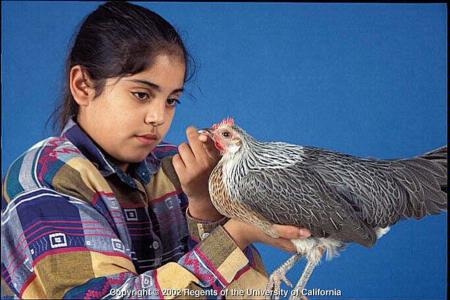
Posts Tagged: Pam Geisel
Urban chickens are fun and a current fad

Among her sources for the story was the director of UC Cooperative Extension's Statewide Master Gardener Program Pamela Geisel, who keeps 10 hens at her own rural home west of Chico.
She said enthusiasm for homegrown hens in urban areas may be close to peaking.
“It’s sort of a fad,” she said. Still, “it’s easy to buy chicks, and they’re cheap."
Most of the potential problems tend to arise from having too many chickens in too little space, she said, so regulations for the size and housing of backyard flocks can “help chicken keepers be better chicken keepers.”
She cautioned that keeping chickens involves a significant effort.
“The poop just doesn’t go away — it’s a constant daily cleanup,” she said. “They get sick, they get parasites. For many people it’s just not worth the effort.”
California's growing marijuana business impacting agriculture
Harry Cline, Western Farm Press
California has the dubious distinction of being America’s biggest marijuana supplier. Approximately 75 percent of the marijuana sold in the U.S. is grown in California — not Mexico.
Michelle Le Strange, UCCE farm advisor in Tulare County, said she has been warned by county officials and law enforcement officers that she should be alert in driving a county vehicle in rural areas because marijuana plantation tenders might think she is a law enforcement officer, and she could be in danger.
Any government officials driving vehicles with government plates should be concerned because these marijuana plantations are operated by Mexican drug cartels, the same lawless gangs who are responsible for thousands of murders each year in Mexico. These cartels actually scour the U.S. Forest Service lands in search of ideal growing sites, often adjacent to running streams. The cartels stock these plantations with people, drip irrigation tubing and chemicals to farm the illegal weed.
Master Gardener news feature 'goes viral'
Alameda County UC Cooperative Extension Master Gardener Birgitt Evans knows a lot about dirt, according to an article in The Bay Citizen. And now, a lot of people know about Birgitt Evans.
Evans sat down for a lengthy interview with reporter Heather Lynn Wood, who published the Q&A session on winter gardening, getting a garden started, composting and tools, and recounted the Master Gardener training process. The result of each volunteer's 17-week certification course, the story said, is an expert gardener armed with a wealth of research-based information and the ability to mentor others.
"Sometimes the work of Master Gardeners goes viral...and we love it!" wrote statewide Master Gardener academic coordinator Pam Geisel in her blog. "Instead of staying local, (the story) made a big splash all over the Bay Area."
Geisel blogged about her delight that the article shared a message about growing vegetables, and also highlighted the statewide Master Gardener program and it's connection to UC. Wood wrote that UC Agriculture and Natural Resources "has representatives like Evans in each California county." ("Well, that is almost true," wrote Geisel.)
The Bay Citizen story is the first in a series of conversations about gardening in Alameda.

Evans says winter is a good time to compost. Above, an MG compost demonstration.
Master Gardeners can't help with this weed
The UC Cooperative Extension Master Gardener program won't give advice about growing marijuana, even if it is grown legally, according to a Los Angeles Times blog post by Jeff Spurrier.
Spurrier, who is himself a volunteer Master Gardener, reported that UC Master Gardener academic coordinator Pam Geisel recently passed along word from the UC Regents general counsel that Master Gardeners cannot offer assistance on marijuana growing, propagation or problem diagnosis.
To be sure, the new edict doesn't require dramatic changes in Master Gardener programs. Inquiries about marijuana production are rare.
The UC Cooperative Extension horticulture advisor in Los Angeles County, Yvonne Savio, told the blogger she knew of only one call to the Master Gardener office about marijuana.
"The caller asked about growing a ‘grass,’ but when our MG suggested growing a drought-tolerant variety, the caller specified, ‘No, I mean marijuana’ to which our MG replied, 'No, I’m sorry, I can’t respond to that,'" Savio was quoted in the post.
Tomatoes get their day in the sun
It's little later than normal due to an unusually cool spring, but California tomato season is now in high gear. Farmers markets, roadside stands and many back yards are teeming with a wide variety of vine-ripened tomatoes, according to an article in yesterday's Sacramento Bee.UC Davis Cooperative Extension post-harvest specialist Marita Cantwell told Bee reporter Niesha Lofing that consumer demand for high-flavor tomatoes has prompted greater availability of a diversity of tomato varieties in hues from golden yellow to deep burgundy.
"Sales are greater if you have more variety," Cantwell was quoted in the story. "The beefs, the rounds, the grape tomatoes – that diversity has stimulated consumption, and that stimulates interest to produce (more varieties)."
Lofing also spoke to Pam Geisel, the UCCE Master Gardener statewide coordinator, who offered a few suggestions for using this summer's tomato bounty:
- Blending different varieties of tomatoes makes a more interesting tomato sauce.
- Sauce need not be cooked for hours. Geisel makes a tomato sauce with fresh basil, fresh garlic, olive oil, salt and pepper in just five minutes.
- No need to blanch and peel tomatoes before cooking. Instead, after cooking, a food mill can quickly separate the peel and seeds from the tomato meat.

Tomatoes and other garden vegetables.